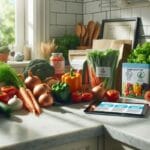Veterinary Contributions to Global Food Security at the WVA’s Global One Health Summit
The American Veterinary Medical Association recently highlighted the role of veterinarians in ensuring global food security at the World Veterinary Association’s (WVA) Global One Health Summit. According to the AVMA report, experts from 70 countries convened to discuss how veterinary science can drive sustainable food systems and bolster resilience in the face of climate change and emerging diseases. Read the full article on the AVMA website.
As global populations surge, veterinarians play a pivotal role in preventing livestock diseases, safeguarding crop pollinators, and advising on food safety protocols. This blog post delves into the Summit’s insights, explores how veterinary interventions shape global food security, and offers practical tips for stakeholders, including consumers with special dietary needs. We’ll also highlight the innovative “Food Scan Genius” tool and its relevance in promoting safe, nutritious diets worldwide.
Key Takeaways
- Veterinarians are essential for preventing animal disease outbreaks that threaten global food security.
- One Health approach integrates human, animal, and environmental health for sustainable food systems.
- Climate-smart livestock practices reduce greenhouse gas emissions and bolster resilience.
- Innovations like Food Scan Genius empower consumers to monitor food safety and nutrition.
- Collaborative research and policy advocacy can accelerate progress toward zero hunger.
Background Context on Veterinary Roles in Food Security
Global food security is the assurance that all people have access to sufficient, safe, and nutritious food. According to the Food and Agriculture Organization (FAO), nearly 690 million people were undernourished in 2019, a figure exacerbated by the COVID-19 pandemic and climate disruptions.
Veterinarians contribute at multiple levels:
- Disease surveillance and control in livestock populations.
- Improving animal welfare to increase productivity.
- Advising farmers on biosecurity measures.
The WVA’s Global One Health Summit emphasized that veterinary professionals help bridge gaps between animal health and human nutrition. By controlling zoonotic diseases and safeguarding pollinators, veterinarians ensure consistent food supplies and protect livelihoods.
Key Summit topics included:
- Antimicrobial resistance and its impact on animal and human health.
- Climate-smart veterinary practices to mitigate environmental footprints.
- Enhancing veterinary education in low- and middle-income countries.
All these efforts directly influence global food security, ensuring that communities worldwide can produce and access healthy foods sustainably.
Medical and Scientific Explanation
Veterinarians apply principles of epidemiology, microbiology, and nutrition science to safeguard food systems. Their interventions include:
- Vaccination campaigns against foot-and-mouth disease, brucellosis, and avian influenza.
- Antibiotic stewardship to limit antimicrobial resistance (CDC on AMR).
- Diagnostic testing for zoonoses at the human-animal interface.
Vaccines reduce morbidity and mortality in livestock, translating to stable meat, dairy, and egg supplies. For example, rinderpest eradication—led by veterinary networks—saved millions from starvation. Antibiotic stewardship programs ensure that critical drugs remain effective for both animals and humans.
Pollinator health is another frontier. Veterinarians research hive health and pesticide impacts on bees, safeguarding the pollination of fruits, nuts, and vegetables. According to the Mayo Clinic, one-third of food crops depend on insect pollination.
By protecting livestock, pollinators, and companion animals, veterinarians maintain ecosystem balance—an essential pillar of the One Health framework. This integrated approach strengthens global food security and community resilience.
Impact on Individuals with Dietary Preferences
The Summit’s outcomes have direct implications for people following specific diets:
- Vegetarians and vegans benefit from healthier, sustainably raised plant-based protein alternatives.
- Individuals with lactose intolerance gain from improved dairy bioengineering and enzyme-treated products.
- People with food allergies can trust better safety protocols in animal feed and processing (see FARE).
Enhanced disease control reduces foodborne illness outbreaks, crucial for immunocompromised and elderly populations. Veterinary research on mycotoxin detection in grains helps gluten-free and celiac patients avoid contamination.
Furthermore, climate-smart animal husbandry supports year-round availability of nutrient-rich foods, such as omega-3–fortified eggs and probiotic yoghurt. These options help individuals maintain balanced macronutrient and micronutrient intake, reducing the risk of deficiencies.
By integrating veterinary science with nutrition, food producers can offer safe, diverse products that meet modern dietary preferences and restrictions, enhancing overall public health.
Practical Advice for Managing Dietary Preferences
Consumers can leverage veterinarian-led innovations and tools to adhere to dietary needs:
- Use traceability systems for animal products. QR codes on packaging can reveal farming practices, antibiotic use, and welfare standards.
- Scan ingredients with apps like Food Scan Genius to detect allergens, additives, and nutrient values in real time.
- Opt for products certified by One Health–aligned labels that ensure animal welfare and environmental sustainability.
Below is a comparison of popular nutrition-scanning apps:
| Feature | Food Scan Genius | Generic Scanner App |
|---|---|---|
| Allergen Detection | AI-driven ingredient analysis | Basic keyword match |
| Nutrition Data | Live USDA database sync | Static offline database |
| User Alerts | Customizable dietary profiles | Fixed warning thresholds |
| One Health Info | Updates on veterinary safety practices | None |
By adopting these tools, individuals can maintain dietary compliance, reduce food waste, and support producers who prioritize animal and environmental health. Always verify app data against authoritative sources such as the NIH.
Related Dietary Preference Research and Developments
Current studies reflect the convergence of veterinary science and nutrition:
- Plant-based meat analogs enriched with veterinary-formulated microalgae (source: PubMed).
- Probiotic strains originally used in livestock now tested for human gut health benefits.
- Gene-edited crops that produce veterinary-grade vaccine proteins, reducing cold-chain dependencies.
One promising development is the integration of Twelve One Health labs studying mycotoxin reduction in staple grains. These efforts promise safer gluten-free flours and corn products for sensitive populations.
Significant funding has been allocated to zoonotic disease modeling to prevent supply chain disruptions. This research underpins robust nutritional interventions and informs global policy on food security standards.
Resources and Support Options
- CDC One Health – Guidelines on integrated health approaches.
- American Veterinary Medical Association – Summit proceedings and policy briefs.
- WHO Food Safety – Technical support for national food safety programs.
Frequently Asked Questions
1. What is the One Health approach?
2. How do veterinarians prevent foodborne illnesses?
3. Can veterinary research benefit people with food allergies?
4. What role does technology like Food Scan Genius play?
5. How can I support global food security efforts?
Conclusion
Veterinarians are vital architects of global food security through disease control, sustainable husbandry, and research innovations. By embracing One Health principles and leveraging tools like Food Scan Genius, stakeholders can ensure safer, more nutritious food supplies. Actionable steps include supporting certified producers, adopting smart scanning apps, and advocating for integrated health policies to build resilient food systems worldwide.




